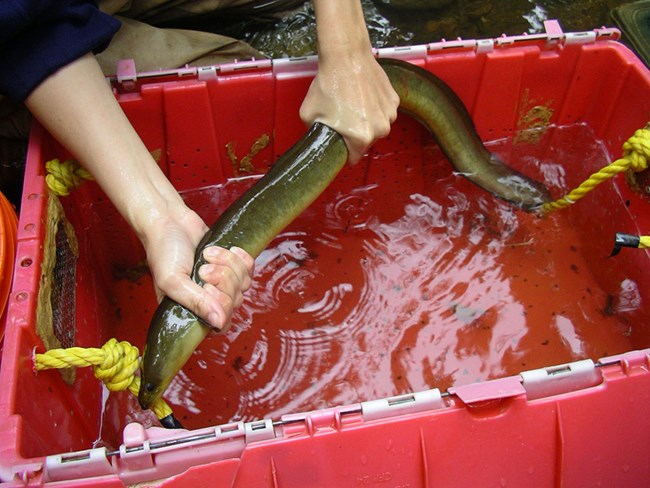A Quick Look
Organisms that live in streams face issues of poor water quality from urban development and other land use.

Importance and Issues
Stream biota are aquatic organisms like fish and macroinvertebrates that are a vital part of healthy stream ecosystems. We monitor fish and benthic (bottom-dwelling) macroinvertebrates in tributary streams of the Potomac and Patuxent Rivers. We also collect data on the physical characteristics of these streams to assess the habitat they provide to stream organisms.
Macroinvertebrates are animals without backbones that are visible to the naked eye. This includes organisms like crayfish, mussels, and the aquatic stages of insects such as midges, stoneflies, mayflies, and caddisflies. They aid in nutrient and carbon cycling and are an important link in stream food webs.
Along with fish, stream macroinvertebrates are good indicators of waterway conditions because of their sensitivity to chemical, physical, and biological disturbances. Fishing is also a popular recreational activity in several NCR parks, and public interest in fish population health is high.
Fish and macroinvertebrates are facing threats to their habitat. Species that rely on cold water, like brook trout, are in peril from climate-induced warming and loss of tree canopy that shades and cools streams. Other threats include pollution from sedimentation, acid deposition, and other sources.
Monitoring Questions and Approach
- What are trends in fish and macroinvertebrate populations?
- What are trends in the physical habitat of streams?
- What non-native fish and macroinvertebrates are present and where?
- Do our streams support any vulnerable aquatic species?
Detailed monitoring objectives from our protocol document are found here.
Source: NPS DataStore Saved Search 1636. To search for additional information, visit the NPS DataStore.
Source: NPS DataStore Saved Search 1301. To search for additional information, visit the NPS DataStore.
How We Monitor
We monitor fish, benthic macroinvertebrates, and physical habitat at thirty-seven freshwater stream sites located in all NCR parks except for the Chesapeake & Ohio Canal. Collaborators from the University of Maryland Center for Environmental Science and Stroud Water Research Center began monitoring in 2019 and completed a full cycle in 2022. The previous monitoring cycle occurred from 2008 to 2014.
This monitoring informs us about the condition of non-tidal first through fourth order streams and rivers in the Potomac and Patuxent watersheds and the organisms that live in them. The assessment of fish and benthic macroinvertebrate monitoring data uses an Index of Biotic Integrity (IBI) scoring system.
Stream physical habitat assessment includes measures of stream width, riparian zone vegetation, degree of vegetated steam buffer, surrounding land use, extent of stream channelization, degree of stream erosion and shading, and other stream features to assess the habitat streams provide to aquatic organisms.
Last updated: November 17, 2025
